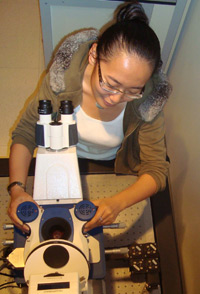Science
Production of Graphene-Based Nanocomposite to Adsorb Water Pollutants

- Read more
- 412 reads
JPK reports on the use of Tip Assisted Optics to characterize biomolecular hydrogels at CIC biomaGUNE in San Sebastian, Spain

PhD student, Xinyue Chen, works with the JPK NanoWizard AFM system in the group of Dr Ralf Richter in San Sebastian.
- Read more
- 387 reads
NASA Radar Images Asteroid 2007 PA8

This composite image of asteroid 2007 PA8 was obtained using data taken by NASA's 230-foot-wide (70-meter) Deep Space Network antenna at Goldstone, Calif. The composite incorporates images generated from data collected at Goldstone on Oct. 28, 29, and 30, 2012.
- Read more
- 444 reads
Opening the curtains at Concordia

The aurora australis, or southern lights, snakes across the permanently dark winter skies of the south pole above the Concordia research station. The misty red band of light known as the Milky Way rises high into the sky.
- Read more
- 412 reads
Advanced Raman Microspectroscopy Offered with Blue, Green, Red and Infrared Lasers

CRAIC Apollo on 2020 Closeup
- Read more
- 387 reads
Hubble Sees an Unexpected Population of Young-Looking Stars
This image was created combining ultraviolet, visual and infrared images taken with the Wide Field Channel of the Advanced Camera for Surveys and the Wide Field Camera 3.
- Read more
- 361 reads
Heat3-PS Dual Mode Sample Heater Supply for Surface Science Applications

- Read more
- 382 reads
October 2012: A Meteoric Month

This is a composite, false-color image that combines meteor fall from various meteor showers (Orionids, Perseids, Geminids) from 2009-2011.
- Read more
- 359 reads
NASA Rover's First Soil Studies Help Fingerprint Martian Minerals

First X-ray View of Martian Soil
This graphic shows results of the first analysis of Martian soil by the Chemistry and Mineralogy (CheMin) experiment on NASA's Curiosity rover. The image reveals the presence of crystalline feldspar, pyroxenes and olivine mixed with some amorphous (non-crystalline) material. The soil sample, taken from a wind-blown deposit within Gale Crater, where the rover landed, is similar to volcanic soils in Hawaii. Curiosity scooped the soil on Oct. 15, 2012, the 69th sol, or Martian day, of operations. It was delivered to CheMin for X-ray diffraction analysis on October 17, 2012, the 71st sol. By directing an X-ray beam at a sample and recording how X-rays are scattered by the sample at an atomic level, the instrument can definitively identify and quantify minerals on Mars for the first time. Each mineral has a unique pattern of rings, or "fingerprint," revealing its presence. The colors in the graphic represent the intensity of the X-rays, with red being the most intense.
- Read more
- 360 reads
NASA Rover Finds Clues to Changes in Mars' Atmosphere

This picture shows a lab demonstration of the measurement chamber inside the Tunable Laser Spectrometer, an instrument that is part of the Sample Analysis at Mars investigation on NASA's Curiosity rover.
- Read more
- 356 reads
Human Rights
Fostering a More Humane World: The 28th Eurasian Economic Summi

Conscience, Hope, and Action: Keys to Global Peace and Sustainability

Ringing FOWPAL’s Peace Bell for the World:Nobel Peace Prize Laureates’ Visions and Actions

Protecting the World’s Cultural Diversity for a Sustainable Future

Puppet Show I International Friendship Day 2020

